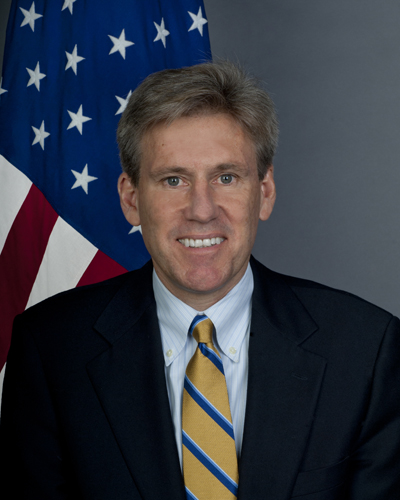J. Christopher Stevens (J. Christopher Stevens)

Stevens was born on April 18, 1960 in Grass Valley, California, the eldest of three siblings born to Jan S. Stevens, a California Assistant Attorney General, and his wife Mary J. Stevens née Floris. from a West Coast of the United States family of French, Swedish and Chinook ancestry. Stevens was raised in Northern California and had two younger siblings, Anne (b. 1962) and Thomas (b. 1965). Stevens’ parents divorced in 1975, and both remarried. He had a half-sister, Hilary (b. 1980), from his father’s second marriage. His mother, a cellist, joined the Marin Symphony Orchestra (1969—2004), and in 1976 married Robert Commanday, a music critic with the San Francisco Chronicle.
Stevens was an AFS Intercultural Programs exchange student in Spain during summer of 1977, and graduated from Piedmont High School in 1978. He earned a B.A. in history in 1982 at the University of California, Berkeley, where he was a member of Alpha Tau Omega fraternity. From 1983 to 1985, he taught English as a Peace Corps volunteer in Morocco. He graduated with a J.D. from the University of California, Hastings College of the Law in 1989, and received an M.S. degree from the National War College in 2010. Prior to joining the United States Foreign Service, Stevens was an international trade lawyer based in Washington, D.C. He was admitted as an active member of the State Bar of California on January 26, 1990; he went on inactive status on August 1, 1991, and remained an inactive member for the remainder of his career.
Stevens joined the United States Foreign Service in 1991. His early overseas assignments included: deputy principal officer and political section chief in Jerusalem; political officer in Damascus; consular/political officer in Cairo and consular/economic officer in Riyadh. In Washington, Stevens served as Director of the Office of Multilateral Nuclear and Security Affairs; Pearson Fellow with the Senate Foreign Relations Committee and Senator Richard Lugar; special assistant to the Under Secretary for Political Affairs; Iran desk officer and staff assistant in the Bureau of Near Eastern Affairs.
He had served in Libya twice previously: as the Deputy Chief of Mission (from 2007 to 2009) and as Special Representative to the National Transitional Council (from March 2011 to November 2011) during the Libyan revolution. He arrived in Tripoli in May 2012 as the U.S. Ambassador to Libya. Stevens spoke English, French and some Arabic.
Stevens was the first U.S. ambassador to die in office since the 1988 airplane crash in Pakistan which killed Arnold Lewis Raphel. Stevens was the eighth U.S. Ambassador to be killed in the line of duty. Obama Administration officials speculated that the attack was a spontaneous response to an online preview of a movie considered offensive to Muslims, but the attackers’ use of military-grade weapons (including RPGs) and apparent knowledge of the secret safe house locations led to speculation that the raid was planned. Libyan officials suggested that it might have been a revenge attack mounted by loyalists (of deceased Libyan leader Muammar Gaddafi) who were defeated in the Libyan Civil War the previous year. Later reports suggested that the attack was coordinated and planned in advance, with any protests either coincidental or possibly diversionary. Libyan president Muhammad Magariaf blamed elements of Ansar al-Sharia for the killing, linking them to Al-Qaeda in the Islamic Maghreb. According to a Libyan-American witness, “There was no demonstration. They came with machine guns, with rockets.”
One of the rocket propelled grenades reportedly created a fire in the main consulate building with three Americans inside– Stevens, Sean Smith, and a security officer. According to U.S. officials, the security officer escaped and the staff found Smith dead. However, the staff were unable to locate Stevens before being driven from the building under small-arms fire. Stevens apparently became separated from his staff while trying to escape to the roof and was allegedly overcome by smoke inhalation. Local civilians found Stevens and brought him to the Benghazi Medical Centre in a state of cardiac arrest. Medical personnel tried to resuscitate him, but he was pronounced dead at about 2 a.m. local time on September 12, 2012.
The surviving Americans were taken to a safe house. A rescue squad consisting of eight U.S. military or former military was sent from Tripoli, the capital. They were ambushed and the safe house came under attack. Two more Americans died, including one sent from Tripoli; several were wounded. Later reports identified the victims as Tyrone S. Woods and Glen A. Doherty, both ex-Navy SEALs working as security and intelligence contractors.
According to the Daily Mail, Ambassador Stevens had sent out a diplomatic cable expressing concerns, on the day he was killed, that security at Benghazi was compromised. Stevens stated that two Libyan security groups were threatening to withdraw over a disagreement on U.S. policy whether centrist politician Mahmoud Jibril would become Libya’s prime minister. John Christopher Stevens is buried in his family’s ancestral plot in Grass Valley, California.
Born
- April, 18, 1960
- USA
- Grass Valley, California
Died
- September, 12, 2012
- Benghazi, Libya
Cemetery
- Forester's Cemetery
- Grass Valley, California
- USA


